Edible Packaging Market Size
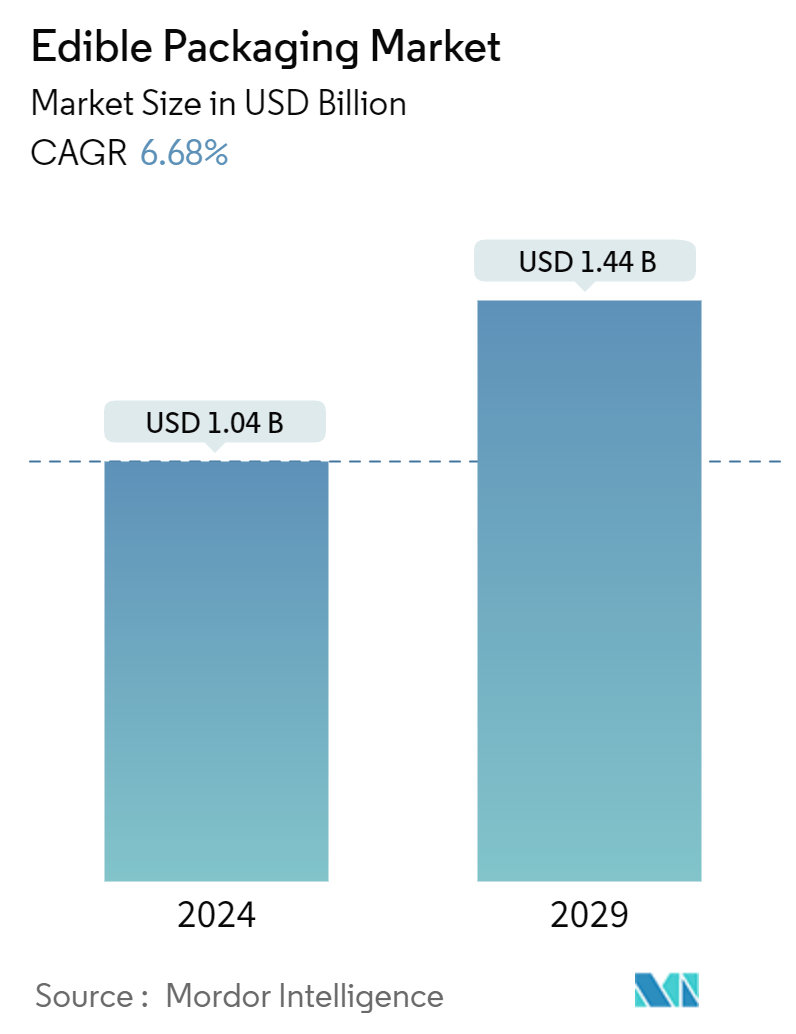
| Study Period | 2019 - 2029 |
| Market Size (2024) | USD 1.04 Billion |
| Market Size (2029) | USD 1.44 Billion |
| CAGR (2024 - 2029) | 6.68 % |
| Fastest Growing Market | Europe |
| Largest Market | North America |
Major Players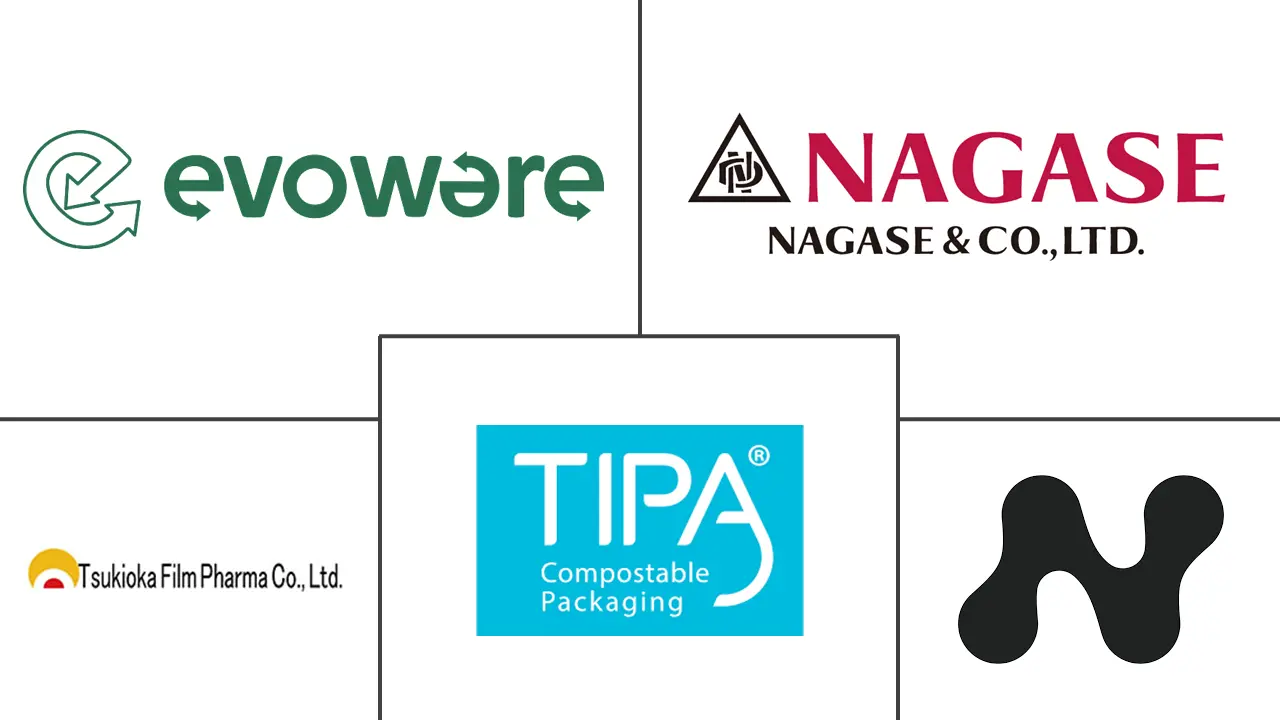
*Disclaimer: Major Players sorted in no particular order |
Edible Packaging Market Analysis
The Edible Packaging Market size is estimated at USD 1.04 billion in 2024, and is expected to reach USD 1.44 billion by 2029, growing at a CAGR of 6.68% during the forecast period (2024-2029).
• Edible packaging, made from plant-based ingredients, can be eaten directly, eliminating the need to process or recycle. With more people caring about the environment, this new type of packaging is an excellent alternative to traditional options. It meets the demand for eco-friendly products and helps reduce waste in landfills.
• Edible packaging protects food from carbon dioxide, fats, moisture, oxygen, and smells. It keeps food fresh and extends its shelf life. One significant advantage is that it can include various active ingredients that improve food safety and nutrition. Edible packaging materials include soybean protein, wheat gluten, whey, and gelatine, attracting businesses to invest in this area.
• In October 2023, Gousto (SCA Investments Limited) introduced the world's first edible pea protein-based packaging, developed with Xampla, a spinout from Cambridge University. This packaging works like plastic, preserving food taste and shelf life, but it is vegan, gluten-free, and eco-friendly.
• Governments and major manufacturers are investing in edible packaging for food and pharmaceutical products. For example, the U.S. Department of Agriculture and the American Chemical Society are developing edible packaging from casein, a milk protein film. This material is 500 times better at protecting food from oxygen.
• With the global ban on plastic, eco-friendly options like edible bags, straws, and containers are becoming more popular. This has increased demand and growth in the packaging sector. Companies making edible products are expanding to meet this demand, leading to more investments in the field.
• A Non-Resident Indian (NRI) from Mangalore, based in Qatar, has created EnviGreen, an eco-friendly carrier bag. These bags look like plastic but are made from natural starch and vegetable oil derivatives. They dissolve in room-temperature water within a day and in boiling water within 15 seconds. Such innovations are expected to boost market demand in the coming years.
• However, edible packaging is more expensive to produce than traditional packaging. The higher cost and the need for secondary packaging to protect against contamination are challenges for the market. Manufacturers have to spend more on protective measures, increasing overall packaging costs.
Edible Packaging Market Trends
The Increasing Demand for Sustainable Solutions and the Need for Extended Product Shelf-Life are helping drive market growth
• Food packaging uses glass, paper, cardboard, metals, and plastic. However, plastic packaging causes many environmental problems. To address this, manufacturers are now focusing on biodegradable and edible food packaging from films and coatings.
• Edible packaging materials vary, including starch, collagen, zein, and gluten-based options. Additives are often added to these materials during film formation to improve their protective qualities. Each type of film has a specific function, mainly acting as a barrier to extend the food's shelf life. The main benefit of edible packaging is that it can be eaten along with food, reducing waste and environmental impact. It also offers physical and nutritional benefits compared to synthetic packaging.
• Consumers are becoming more health-conscious and interested in plant-based foods. In response, food manufacturers are working harder to extend shelf life and improve packaging technology to ensure food safety and preservation.
• At the same time, researchers and technological institutions are developing new edible films using different components, which helps the market grow. For example, in August 2023, the food tech startup Foodberry created plant-based edible coverings from fruit skins. These coverings help extend the shelf life of moisture-sensitive foods like ice cream and hummus.
• With growing concerns about climate change, plastic pollution, and other environmental issues, sustainable packaging is the best option. Businesses can significantly reduce their environmental impact using biodegradable or renewable materials like plant-based options.
• Additionally, more consumers are willing to pay extra for sustainable packaging. According to the National Association of Convenience Stores (NACS), a leading global trade association for convenience and fuel retailing, about 80% of consumers are now concerned about the environmental impact of their purchases, up from 68% in 2023 and 66% in 2022. This is expected to have a fair effect on the studied market.
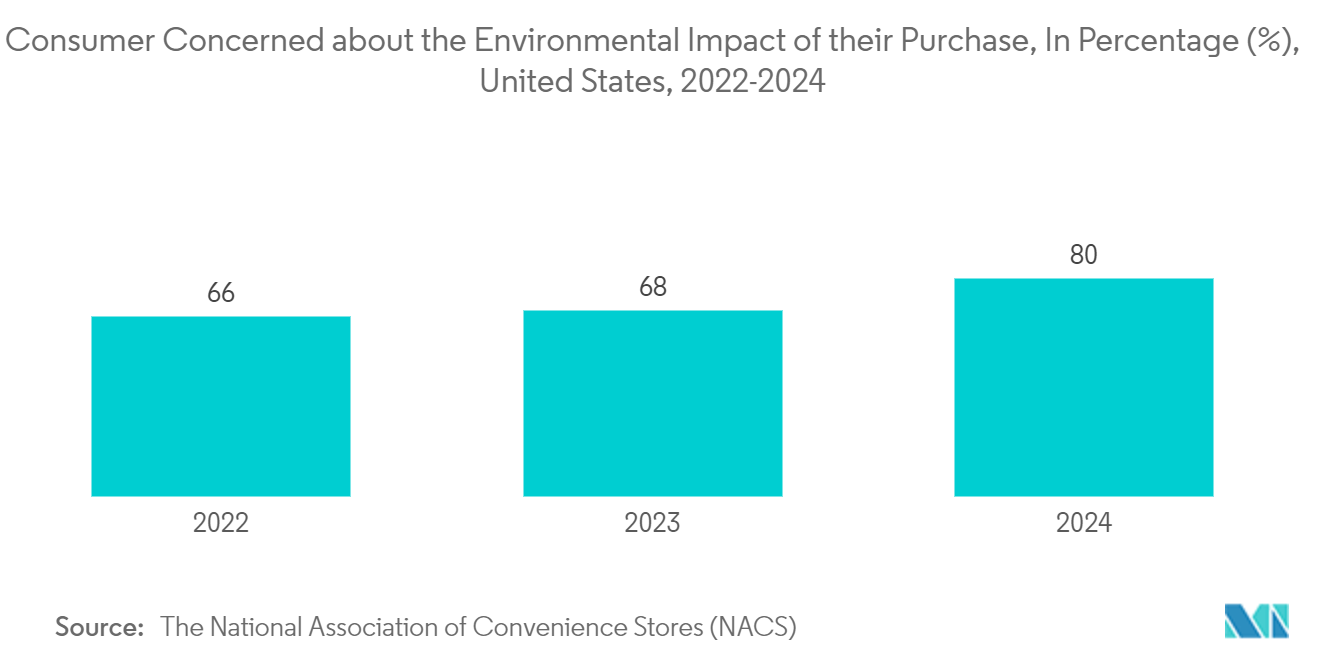
A Sustainable Revolution in the European Region Aids the Market Growth
• Research and development (R&D) efforts are growing, particularly in regions like the United Kingdom. These efforts focus on creating edible packaging, often from materials like seaweed. The main goal for these innovators is to make packaging that's useful and safe to eat, avoiding traditional landfills and ocean pollution. Notpla Limited, a UK-based sustainable packaging company, is a great example. Notpla's work in seaweed-based packaging earned it the prestigious Earthshot Prize, a well-known award in the sustainable packaging field.
• Showing the practicality of these innovations, in April 2023, Notpla's product, Ooho, was a hit at a marathon in Gothenburg. Ooho replaced over 20,000 regular plastic cups, giving runners an eco-friendly way to hydrate on the go. Its all-natural, edible design improved the runners' experience and significantly reduced single-use plastic use.
• For example, Traceless, a German startup, has developed a new process that turns agricultural waste, like starch and brewery residues, into various products, from plastic films to hard materials. These materials, made from plant residues, are fully compostable. Depending on their thickness, they can break down in 2-9 weeks, either in a home compost bin or through anaerobic digestion, producing biogas. Such innovations are expected to boost the edible packaging market.
• The European Union's ban on single-use plastic products, including cups and straws, has dramatically affected market trends. Packaging manufacturers have quickly responded by introducing edible straws as a sustainable alternative. In April 2023, EdibleStraws, a leader in sustainable food solutions, launched its latest product, edible straws, further supporting the move away from traditional plastic and paper straws.
• The edible packaging market is significantly changing as the region faces growing sustainability concerns and stricter rules on single-use plastics. The market is set for solid growth with many players and increased R&D investments.
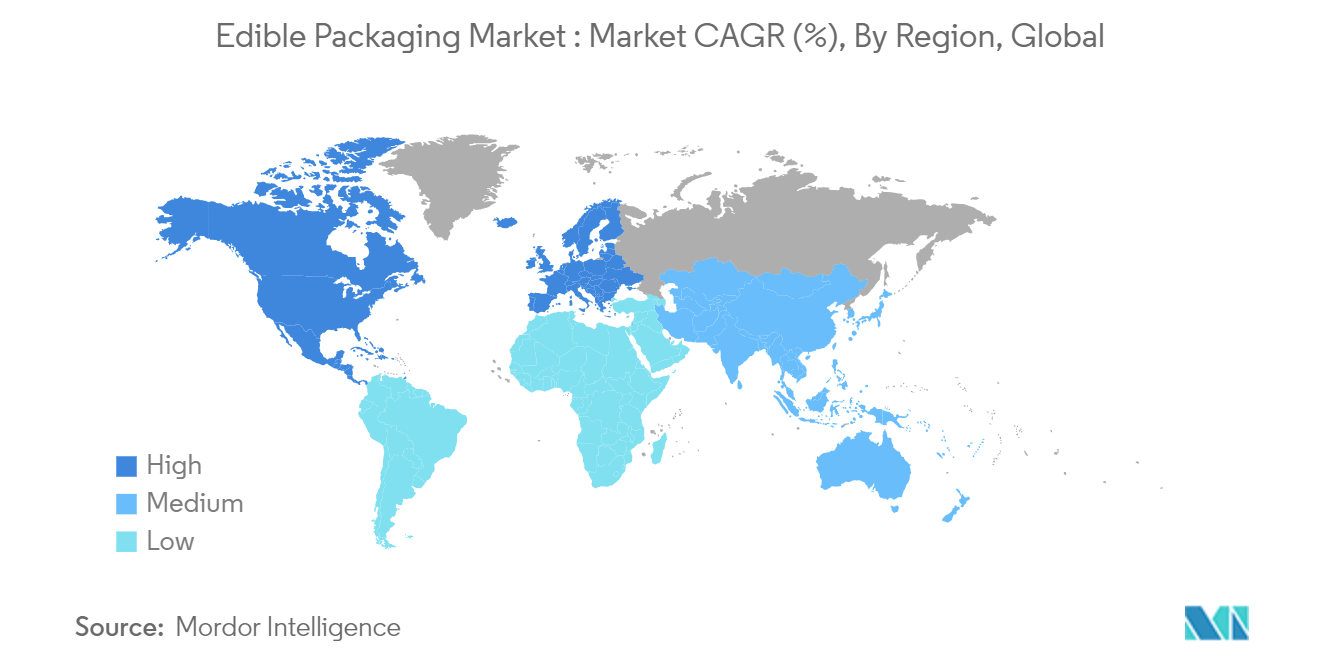
Edible Packaging Industry Overview
The edible packaging market is semi-consolidated due to limited market players. The key players operating in the market include Nagase America LLC (Nagase & Co. Ltd), Evoware (PT. Evogaia Karya Indonesia), Notpla Limited, Tipa Corp Ltd, TSUKIOKA FILM PHARMA CO. LTD, Devro PLC (Saria Nederland BV), and JRF Technology LLC, among others. The players focus on expanding their market share and investing in research and development (R&D) to develop innovative products.
• July 2023 - Notpla Limited expanded its presence in Europe by scaling up the availability of seaweed-based coated boards and launching into the Benelux region. The availability of seaweed-based coated boards would gain traction among environmentally-conscious businesses.
• May 2023 - Nagase America LLC announced the formation of its Emerging Technologies Team that will focus on exploring and de-risk new business opportunities with high potential and drive the exploratory phase of product development. The formation of a new team will help the company Deliver the Next technology, products, and services in the Americas and drive the business's transformation.
Edible Packaging Market Leaders
-
Tipa Corp Ltd.
-
Nagase America LLC (Nagase & Co., Ltd.)
-
Evoware (PT. Evogaia Karya Indonesia)
-
Notpla Limited
-
TSUKIOKA FILM PHARMA CO., LTD.
*Disclaimer: Major Players sorted in no particular order
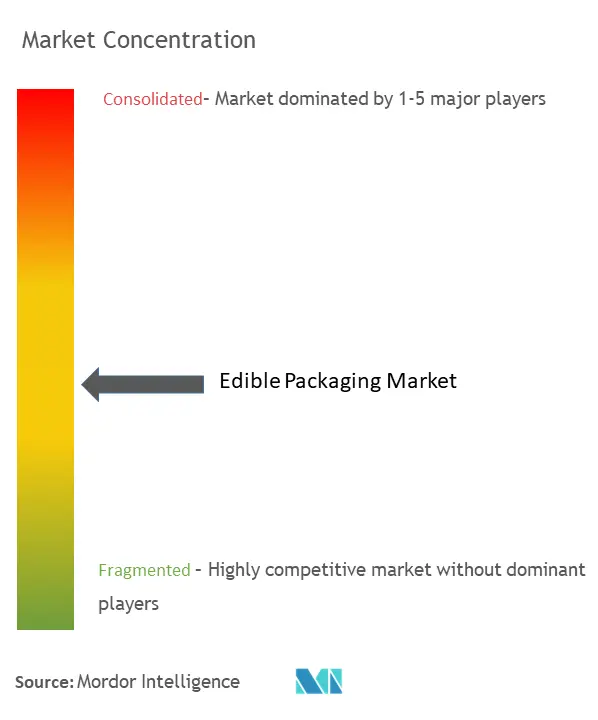
Edible Packaging Market News
• September 2023 – Saveggy AB partnered with odlarna.se, a Swedish-grown cucumber and tomato producer, to create production and packaging lines and application technology for its plant-based edible coating. This will lead to replacing fossil-based plastic wrapping for cucumbers.
• June 2023 - A prototype packaging machine was designed by research scholars at the Institute of Home Science and Higher Education for women in Avinashilingam to facilitate research on packaging. The machine has been designed to produce edible and environmentally friendly packaging material.
• April 2023 - a team of students at the Hohenheim University of Stuttgart created EDGGY’s eggshell-based edible packaging. The eggshells, as well as other plant-derived raw materials, are easily dissolved in hot water and can be consumed as an additional source of protein. For the sustainable and innovative concept, the five EGGY students were awarded the EIT’s most innovative idea award and prize money for the food reuse2repack challenge.
Edible Packaging Market Report - Table of Contents
1. INTRODUCTION
- 1.1 Study Assumptions and Market Definition
- 1.2 Scope of the Study
2. RESEARCH METHODOLOGY
3. EXECUTIVE SUMMARY
4. MARKET INSIGHTS
- 4.1 Market Overview
-
4.2 Industry Attractiveness - Porter's Five Forces Analysis
- 4.2.1 Bargaining Power of Suppliers
- 4.2.2 Bargaining Power of Buyers
- 4.2.3 Threat of New Entrants
- 4.2.4 Threat of Substitutes
- 4.2.5 Intensity of Competitive Rivalry
- 4.3 Industry Value Chain Analysis
5. MARKET DYNAMICS
-
5.1 Market Drivers
- 5.1.1 Need to Eliminate Type Waste Cycle and Increase Shelf-Life of the Product
- 5.1.2 Ban on Single-Use-Plastic and Growing Sustainability Concern
-
5.2 Market Restraints
- 5.2.1 High Cost of Production
6. MARKET SEGMENTATION
-
6.1 By Source
- 6.1.1 Plant
- 6.1.2 Animal
-
6.2 By Raw Material
- 6.2.1 Protein
- 6.2.2 Polysaccharides
- 6.2.3 Lipids
- 6.2.4 Other Raw Materials
-
6.3 By End-User Industry
- 6.3.1 Food
- 6.3.2 Bevergae
- 6.3.3 Pharmaceutical
-
6.4 By Region
- 6.4.1 North America
- 6.4.1.1 United States
- 6.4.1.2 Canada
- 6.4.2 Europe
- 6.4.2.1 Germany
- 6.4.2.2 United Kingdom
- 6.4.2.3 France
- 6.4.2.4 Italy
- 6.4.3 Asia-Pacific
- 6.4.3.1 China
- 6.4.3.2 Japan
- 6.4.3.3 India
- 6.4.3.4 Australia and New Zealand
- 6.4.4 Latin America
- 6.4.5 Middle East and Africa
7. COMPETITIVE LANDSCAPE
-
7.1 Company Profiles
- 7.1.1 Devro PLC (Saria Nederland BV)
- 7.1.2 Nagase America LLC (Nagase & Co., Ltd.)
- 7.1.3 JRF Technology, LLC
- 7.1.4 Evoware (PT. Evogaia Karya Indonesia)
- 7.1.5 Notpla Limited
- 7.1.6 Tipa Corp Ltd.
- 7.1.7 Amtrex Nature Care Pvt. Ltd.
- 7.1.8 Envigreen Biotech India Private Ltd.
- 7.1.9 TSUKIOKA FILM PHARMA CO., LTD.
- 7.1.10 ECOLOTEC LIMITED
- 7.1.11 Glanbia plc
- *List Not Exhaustive
8. INVESTMENT ANALYSIS
9. FUTURE OF THE MARKET
** Subject To AvailablityEdible Packaging Industry Segmentation
Edible packaging is a sustainable solution designed to be eaten or biodegraded, commonly made from plant- or animal-based sources. Edible packaging works as an alternative to plastic packaging and helps reduce plastic waste as everything is eaten or biodegraded. It helps reduce waste and reduces the need for recycling. Continuous research and development (R&D) are carried out by the vendors operating in the market to offer better product offerings adhering to the end-user industry requirement. The edible packaging market is expected to experience more innovation in the coming years, and mergers and acquisitions are expected in the industry. New brands have gained traction in the last few years due to the quality of their offerings.
The edible packaging market is segmented by source (plant and animal), raw material (protein, polysaccharides, lipids, and other raw materials), end-user industry (food, beverage, and pharmaceutical), and Geography (North America [United States and Canada], Europe [Germany, United Kingdom, France, Italy, and Rest of Europe], Asia-Pacific [China, Japan, India, Australia and New Zealand, and Rest of Asia Pacific], Latin America, Middle East and Africa). The report offers market forecasts and size in value (USD) for all the above segments.
| By Source | Plant | |
| Animal | ||
| By Raw Material | Protein | |
| Polysaccharides | ||
| Lipids | ||
| Other Raw Materials | ||
| By End-User Industry | Food | |
| Bevergae | ||
| Pharmaceutical | ||
| By Region | North America | United States |
| Canada | ||
| By Region | Europe | Germany |
| United Kingdom | ||
| France | ||
| Italy | ||
| By Region | Asia-Pacific | China |
| Japan | ||
| India | ||
| Australia and New Zealand | ||
| By Region | Latin America | |
| Middle East and Africa |
Edible Packaging Market Research FAQs
How big is the Edible Packaging Market?
The Edible Packaging Market size is expected to reach USD 1.04 billion in 2024 and grow at a CAGR of 6.68% to reach USD 1.44 billion by 2029.
What is the current Edible Packaging Market size?
In 2024, the Edible Packaging Market size is expected to reach USD 1.04 billion.
Who are the key players in Edible Packaging Market?
Tipa Corp Ltd., Nagase America LLC (Nagase & Co., Ltd.), Evoware (PT. Evogaia Karya Indonesia), Notpla Limited and TSUKIOKA FILM PHARMA CO., LTD. are the major companies operating in the Edible Packaging Market.
Which is the fastest growing region in Edible Packaging Market?
Europe is estimated to grow at the highest CAGR over the forecast period (2024-2029).
Which region has the biggest share in Edible Packaging Market?
In 2024, the North America accounts for the largest market share in Edible Packaging Market.
What years does this Edible Packaging Market cover, and what was the market size in 2023?
In 2023, the Edible Packaging Market size was estimated at USD 0.97 billion. The report covers the Edible Packaging Market historical market size for years: 2019, 2020, 2021, 2022 and 2023. The report also forecasts the Edible Packaging Market size for years: 2024, 2025, 2026, 2027, 2028 and 2029.
Edible Packaging Industry Report
Statistics for the 2024 Edible Packaging market share, size and revenue growth rate, created by Mordor Intelligence™ Industry Reports. Edible Packaging analysis includes a market forecast outlook for 2024 to 2029 and historical overview. Get a sample of this industry analysis as a free report PDF download.



